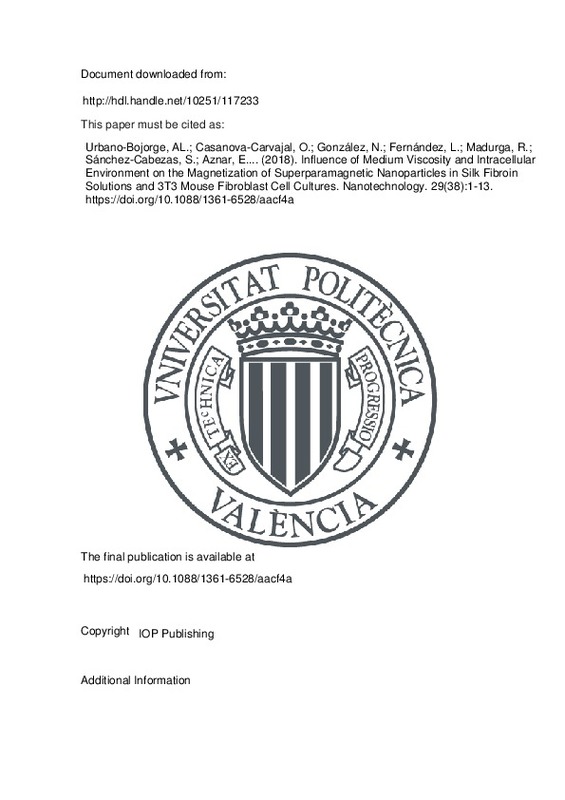JavaScript is disabled for your browser. Some features of this site may not work without it.
Buscar en RiuNet
Listar
Mi cuenta
Estadísticas
Ayuda RiuNet
Admin. UPV
Influence of Medium Viscosity and Intracellular Environment on the Magnetization of Superparamagnetic Nanoparticles in Silk Fibroin Solutions and 3T3 Mouse Fibroblast Cell Cultures
Mostrar el registro sencillo del ítem
Ficheros en el ítem
| dc.contributor.author | Urbano-Bojorge, Ana Lorena
|
es_ES |
| dc.contributor.author | Casanova-Carvajal, Oscar
|
es_ES |
| dc.contributor.author | González, N.F.
|
es_ES |
| dc.contributor.author | Fernández, Laura
|
es_ES |
| dc.contributor.author | Madurga, Rodrigo
|
es_ES |
| dc.contributor.author | Sánchez-Cabezas, Santiago
|
es_ES |
| dc.contributor.author | Aznar, Elena
|
es_ES |
| dc.contributor.author | Ramos, Milagros
|
es_ES |
| dc.contributor.author | Serrano, J.J.
|
es_ES |
| dc.date.accessioned | 2019-02-23T21:06:06Z | |
| dc.date.available | 2019-02-23T21:06:06Z | |
| dc.date.issued | 2018 | es_ES |
| dc.identifier.issn | 0957-4484 | es_ES |
| dc.identifier.uri | http://hdl.handle.net/10251/117233 | |
| dc.description | IOP also requests that you include the following statement of provenance: "This is an author-created, un-copyedited versíon of an article published in Nanotechnology. IOP Publishing Ltd is not responsíble for any errors or omissíons in this versíon of the manuscript or any versíon derived from it. The Versíon of Record is available online at https://doi.org/10.1088/1361-6528/aacf4a. | |
| dc.description.abstract | [EN] Biomedical applications based on the magnetic properties of superparamagnetic iron oxide nanoparticles (SPIONs) may be altered by the mechanical attachment or cellular uptake of these nanoparticles. When nanoparticles interact with living cells, they are captured and internalized into intracellular compartments. Consequently, the magnetic behavior of the nanoparticles is modified. In this paper, we investigated the change in the magnetic response of 14 nm magnetic nanoparticles (Fe3O4) in different solutions, both as a stable liquid suspension (one of them mimicking the cellular cytoplasm) and when associated with cells. The field-dependent magnetization curves from inert fluids and cell cultures were determined by using an alternating gradient magnetometer, MicroMagTM 2900. The equipment was adapted to measure liquid samples because it was originally designed only for solids. In order to achieve this goal, custom sample holders were manufactured. Likewise, the nuclear magnetic relaxation dispersion profiles for the inert fluid were also measured by fast field cycling nuclear magnetic relaxation relaxometry. The results show that SPION magnetization in inert fluids was affected by the carrier liquid viscosity and the concentration. In cell cultures, the mechanical attachment or confinement of the SPIONs inside the cells accounted for the change in the dynamic magnetic behavior of the nanoparticles. Nevertheless, the magnetization value in the cell cultures was slightly lower than that of the fluid simulating the viscosity of cytoplasm, suggesting that magnetization loss was not only due to medium viscosity but also to a reduction in the mechanical degrees of freedom of SPIONs rotation and translation inside cells. The findings presented here provide information on the loss of magnetic properties when nanoparticles are suspended in viscous fluids or internalized in cells. This information could be exploited to improve biomedical applications based on magnetic properties such as magnetic hyperthermia, contrast agents and drug delivery. | es_ES |
| dc.description.sponsorship | The authors are thankful to their supporters: a grant from Universidad Politecnica de Madrid to Ana Lorena Urbano-Bojorge and a grant from Universidad Nacional Experimental del Tachira (UNET)- Venezuela to Oscar Casanova-Carvajal. This study was also financially supported in part by CIBER-BBN (Spain) and Madr.ib-CM (Spain). | |
| dc.language | Inglés | es_ES |
| dc.publisher | IOP Publishing | es_ES |
| dc.relation.ispartof | Nanotechnology | es_ES |
| dc.rights | Reserva de todos los derechos | es_ES |
| dc.subject | Superparamagnetic iron oxide nanoparticles (SPIONs) | es_ES |
| dc.subject | Silkworm fibroin solutions | es_ES |
| dc.subject | 3T3 mouse fibroblast cell line | es_ES |
| dc.subject | Alternating gradient magnetometer (AGM) | es_ES |
| dc.subject | Fast field cycling nuclear magnetic relaxation relaxometry (FFCNMR) | es_ES |
| dc.subject | Viscosity | es_ES |
| dc.subject.classification | QUIMICA INORGANICA | es_ES |
| dc.title | Influence of Medium Viscosity and Intracellular Environment on the Magnetization of Superparamagnetic Nanoparticles in Silk Fibroin Solutions and 3T3 Mouse Fibroblast Cell Cultures | es_ES |
| dc.type | Artículo | es_ES |
| dc.identifier.doi | 10.1088/1361-6528/aacf4a | es_ES |
| dc.rights.accessRights | Abierto | es_ES |
| dc.date.embargoEndDate | 2019-09-21 | es_ES |
| dc.contributor.affiliation | Universitat Politècnica de València. Instituto de Reconocimiento Molecular y Desarrollo Tecnológico - Institut de Reconeixement Molecular i Desenvolupament Tecnològic | es_ES |
| dc.description.bibliographicCitation | Urbano-Bojorge, AL.; Casanova-Carvajal, O.; González, N.; Fernández, L.; Madurga, R.; Sánchez-Cabezas, S.; Aznar, E.... (2018). Influence of Medium Viscosity and Intracellular Environment on the Magnetization of Superparamagnetic Nanoparticles in Silk Fibroin Solutions and 3T3 Mouse Fibroblast Cell Cultures. Nanotechnology. 29(38):1-13. https://doi.org/10.1088/1361-6528/aacf4a | es_ES |
| dc.description.accrualMethod | S | es_ES |
| dc.relation.publisherversion | https://doi.org/10.1088/1361-6528/aacf4a | es_ES |
| dc.description.upvformatpinicio | 1 | es_ES |
| dc.description.upvformatpfin | 13 | es_ES |
| dc.type.version | info:eu-repo/semantics/publishedVersion | es_ES |
| dc.description.volume | 29 | es_ES |
| dc.description.issue | 38 | es_ES |
| dc.identifier.pmid | 29947336 | |
| dc.relation.pasarela | S\366365 | es_ES |
| dc.contributor.funder | Universidad Politécnica de Madrid | |
| dc.contributor.funder | Universidad Nacional Experimental del Táchira, Venezuela | |
| dc.contributor.funder | Centro de Investigación Biomédica en Red en Bioingeniería, Biomateriales y Nanomedicina |







![[Cerrado]](/themes/UPV/images/candado.png)

